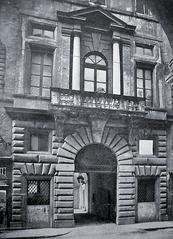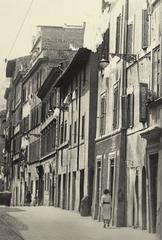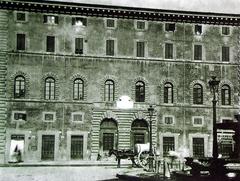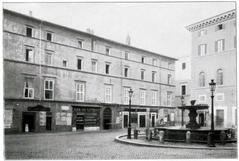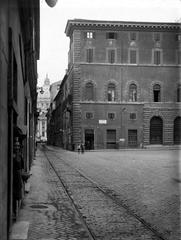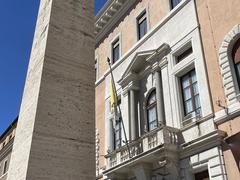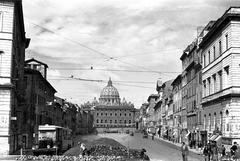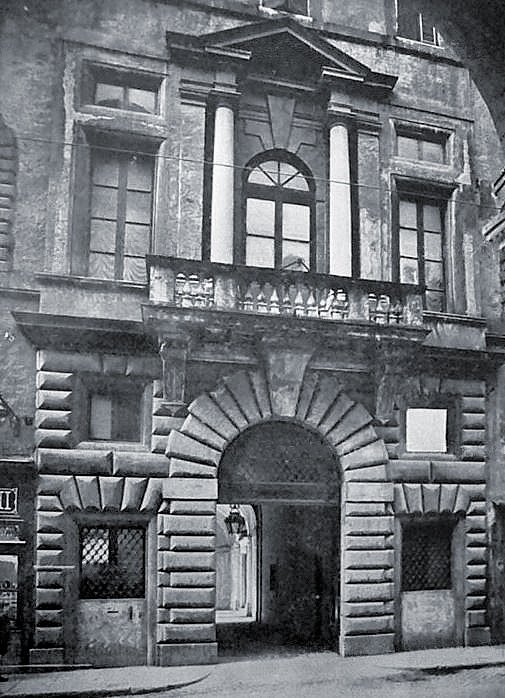
Palazzo dei Convertendi: Visiting Hours, Tickets, and Guide to Rome Historical Sites
Date: 14/06/2025
Introduction
Situated along the renowned Via della Conciliazione in Rome’s historic Borgo district, the Palazzo dei Convertendi stands as a testament to Renaissance innovation, religious transformation, and urban evolution. Originally completed in the early 16th century, the palazzo is closely associated with the celebrated artist Raphael, who is believed to have lived and died there. Its enduring significance is tied to its later function as a residence and educational center for converts to Christianity during the Counter-Reformation—a mission reflected in its very name, “dei Convertendi,” or “of the converts.”
Although today the building primarily houses the Vatican’s Congregation for the Oriental Churches and is not generally accessible to the public, its harmonious façade and rich historical narrative continue to captivate visitors. The palazzo’s proximity to such icons as St. Peter’s Basilica and the Vatican Museums makes it a key landmark for those seeking to understand the layered story of Rome’s religious and architectural heritage.
This comprehensive guide will provide a detailed overview of the Palazzo dei Convertendi’s history, architectural features, cultural significance, practical visiting information, accessibility, and nearby attractions—ensuring an enriching experience for every history enthusiast exploring Rome.
For further reading, consult the Official Palazzo dei Convertendi website, Rome Tourism portal, and ItalyScapes.
Table of Contents
- Introduction
- Historical Overview
- Artistic and Cultural Significance
- Visiting Palazzo dei Convertendi
- Architectural Features and Innovations
- Preservation of Original Elements
- Relationship with the Urban Context
- Frequently Asked Questions (FAQ)
- Additional Resources and Links
- Conclusion and Call to Action
Historical Overview
Origins and Early History
The Palazzo dei Convertendi traces its origins to the Renaissance, first documented in the early 16th century. Originally known as Palazzo Caprini and attributed to Donato Bramante, the building gained prominence as the residence of Raphael (Raffaello Sanzio), who lived there until his death in 1520 (Wikipedia; ItalyScapes). Its association with Raphael, and the building’s refined architectural style, have contributed to its lasting prestige.
Later, the palace became the headquarters of the Congregation of the Neophytes and Catechumens, serving as a residence and support center for Jewish and Muslim converts to Christianity—a role that gave rise to its current name (Turismo Roma; Aurica.ai).
Architectural Evolution
Having started as a Renaissance residence, the palazzo was gradually augmented with Baroque embellishments, including stucco decorations and painted details by notable artists. The façade’s elegant proportions and use of rusticated stonework became influential in Roman palatial architecture (ItalyScapes).
Institutional Role in the 17th–18th Centuries
During the 17th century, under Pope Gregory XIII, the building was formally established as the Collegio dei Neofiti (College of the Neophytes) (Rome Tourism). It became a center for catechetical instruction, social support, and vocational training for converts—a role that lasted well into the modern era.
19th–20th Century: Urban Changes and Preservation
Rome’s urban landscape shifted dramatically in the 20th century with the creation of Via della Conciliazione. The original building was dismantled between 1937 and 1941 as part of Mussolini’s urban renewal, but its façade and significant elements were carefully salvaged and reconstructed at the current site (ItalyScapes). This meticulous relocation, directed by Giuseppe Momo, preserved its Renaissance character while integrating it into the new ceremonial avenue.
Artistic and Cultural Significance
The Palazzo dei Convertendi is more than an architectural landmark—it’s a symbol of Rome’s religious transformation and Renaissance artistry. Its rusticated portal, attributed to Baldassarre Peruzzi, and the harmonious arrangement of windows and loggia exemplify the ideals of Renaissance design (Turismo Roma).
The palace’s legacy as a refuge for converts underscores its ongoing role in fostering religious dialogue and cultural integration. Today, it houses the Congregation for the Oriental Churches, maintaining its tradition of outreach and spiritual engagement (Vatican.va).
Visiting Palazzo dei Convertendi
Location and Exterior Access
Address: Via della Conciliazione 34, Rome, Italy
Metro: Ottaviano (Line A), approximately a 10-minute walk
Bus: Traspontina/Conciliazione stop, served by lines 23, 40, and 982
Note: The palace’s interior is not open for regular public visits, as it houses Vatican offices. However, the façade can be admired at any time from Via della Conciliazione.
Visiting Hours and Ticket Information
- Regular Visits: The palazzo is not open to the public for daily tours.
- Special Events: Occasionally opens for cultural events such as Open House Roma (usually in May or June). Admission is free during these events but may require advance reservation (Open House Rome).
- Guided Tours: Available only during special events or by arrangement with select tour operators.
Accessibility
The main entrance is accessible, and the surrounding area is generally suitable for visitors with mobility needs. Some interior areas may have steps or uneven flooring due to the building’s historic nature; confirm accessibility when booking special event tours.
Travel Tips and Nearby Attractions
- Nearby Sites: St. Peter’s Basilica, Vatican Museums, Castel Sant’Angelo, Piazza Navona, and other Borgo district highlights are all within walking distance.
- Dining: Numerous cafés and restaurants are located along Via della Conciliazione and adjacent streets.
- Dress Code: Modest attire is recommended, especially during religious or official events.
- Photography: Photography of the exterior is permitted. Interior photography policies depend on event organizers.
Architectural Features and Innovations
- Façade: The reconstructed façade is a faithful evocation of the original Renaissance design, with a rusticated portal, symmetrical windows, and a classical loggia (The Center of Rome B&B).
- Rustication: Early use of rusticated stone blocks on the ground floor, a feature that influenced later Roman palaces (Wikipedia).
- Window Arrangements: The noble floor features rusticated arched windows; the upper level is characterized by simple rectangular openings, achieving harmony and balance.
- Preserved Elements: The original portal and balcony were carefully dismantled and integrated into the new structure. Some window frames from the original building were also reused (ItalyScapes).
Preservation and Urban Integration
The building’s relocation and reconstruction highlight Rome’s approach to balancing modernization with heritage preservation. The palazzo, now part of a row of reconstructed Renaissance buildings on Via della Conciliazione, contributes to the grand processional route leading to St. Peter’s Basilica and maintains the historic character of the Borgo district (Wikipedia).
Frequently Asked Questions (FAQ)
Q: Can I visit the Palazzo dei Convertendi interior?
A: The interior is not open to the public except during special events like Open House Roma.
Q: Are tickets required?
A: No tickets are required for viewing the exterior. For special events, booking may be necessary.
Q: Is the building accessible to those with limited mobility?
A: Yes, the main entrance and surrounding area are accessible. Some interior areas may present challenges during special events.
Q: Are guided tours available?
A: Guided tours are occasionally organized during cultural events. Check event listings or with local tour operators.
Q: What else can I see nearby?
A: St. Peter’s Basilica, Vatican Museums, Castel Sant’Angelo, and other landmarks are within easy walking distance.
Additional Resources and Useful Links
- Official Palazzo dei Convertendi Website
- Rome Tourism
- ItalyScapes
- Open House Rome
- The Roman Guy – Jubilee Guide
- Travel + Leisure – Rome Jubilee 2025
Conclusion and Call to Action
Palazzo dei Convertendi embodies Rome’s Renaissance artistry, religious legacy, and resilience through urban transformation. While its interior is not generally accessible, its imposing façade and historical resonance make it a vital landmark for any Rome itinerary, especially for those exploring Vatican-adjacent neighborhoods. For in-depth information, guided experiences, and updates on special openings, consult the official resources listed above.
Enhance your journey:
- Download the Audiala app for curated tours, real-time updates, and exclusive content on Rome’s historical sites.
- Follow us on social media for the latest travel tips, event notifications, and insider recommendations.
- Plan your itinerary to explore nearby treasures like St. Peter’s Basilica, Vatican Museums, and Castel Sant’Angelo for a complete immersion in Rome’s spiritual and artistic heritage.
References
- Palazzo dei Convertendi: A Historical Gem in Rome with Visitor Information, 2025, Aurica.ai (https://aurica.ai/en/article/martin-sparks/palazzo-dei-convertendi/)
- Palazzo dei Convertendi Visiting Hours, Tickets, and Historical Significance in Rome, 2025, Turismo Roma (https://www.turismoroma.it/en/places/palazzo-dei-convertendi-o-delle-congrazioni-delle-chiese-orientali)
- Palazzo dei Convertendi Visiting Hours, Tickets & History | Rome Historical Sites Guide, 2025, Open House Rome (https://www.romeing.it/open-house-rome/)
- Palazzo dei Convertendi: Visiting Hours, Tickets, and Historical Significance in Rome, 2025, The Roman Guy (https://theromanguy.com/italy-travel-blog/rome/the-ultimate-guide-to-rome-jubilee/)
- Palazzo dei Convertendi: Visiting Hours, Tickets, and Historical Significance in Rome, 2025, Travel + Leisure (https://www.travelandleisure.com/rome-jubilee-2025-what-travelers-should-know-8721233)
- Palazzo dei Convertendi Visiting Hours, Tickets, and Historical Significance in Rome, 2025, ItalyScapes (https://www.italyscapes.com/places/lazio/rome/palaces/palazzo-dei-convertendi/)
- Palazzo dei Convertendi, Wikipedia, 2025 (https://en.wikipedia.org/wiki/Palazzo_dei_Convertendi)
